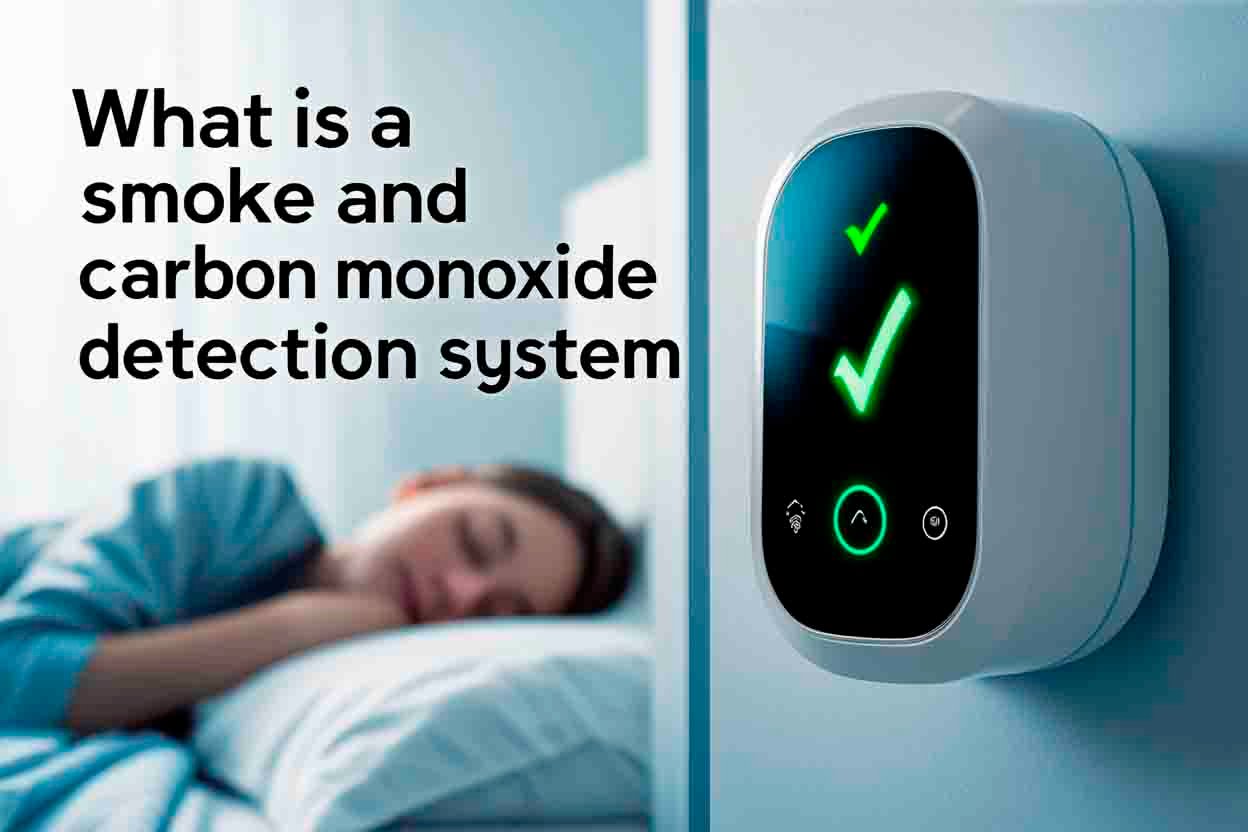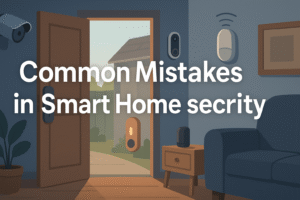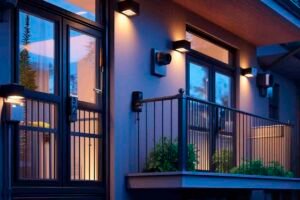When it comes to keeping your home and family safe, fire and invisible gases are two of the biggest threats. That’s where a smoke and carbon monoxide detection system comes in. These smart safety devices provide early warnings that can literally save lives. But what exactly are they, and why are they so important in a modern home? Let’s break it down in simple terms.
Why You Need Smoke and Carbon Monoxide Detection
When it comes to home safety, two of the biggest dangers are fire and carbon monoxide (CO)—and both can spread faster than you might think.
- Smoke from a fire can fill a home within minutes. Even a small kitchen fire can produce toxic fumes long before flames become visible. Breathing in smoke can cause confusion, dizziness, and loss of consciousness, making it extremely difficult to escape without early warning. That’s why a reliable smoke detection system is critical—it buys you precious time to act.
- Carbon monoxide, on the other hand, is an invisible threat. Often called the “silent killer”, CO has no smell, color, or taste. It can leak from common household appliances such as gas stoves, furnaces, fireplaces, or water heaters. Because you can’t detect it naturally, exposure can happen while you’re sleeping or going about your daily routine. Even low levels can cause headaches and fatigue, while higher levels can be deadly.
A combined smoke and carbon monoxide detection system is your first line of defense against these threats. By continuously monitoring the air in your home, it ensures you’ll be alerted the moment smoke particles or dangerous CO levels are detected.
Today’s smart detectors take this protection even further. They can send instant alerts to your phone, trigger connected smart lights or alarms, and keep your family safe even when you’re away from home. This level of awareness and control is not just about convenience—it’s about peace of mind.
In short, you need a smoke and CO detection system because it saves lives, reduces risks, and gives you time to react in emergencies that could otherwise turn tragic.
Imagine This Scenario
It’s 2 a.m. and your whole family is asleep. Suddenly, a small electrical fault in the living room sparks a fire. Within minutes, smoke begins to spread through the house. Without an alarm, you might not wake up in time. But with a smoke detection system, the piercing alarm goes off instantly, giving you those extra minutes to get everyone out safely.
Now consider another situation: the furnace develops a hidden fault, releasing carbon monoxide into the air. There’s no smell, no color—just silence. While you sleep, the gas builds up, making the air more dangerous with every breath. In this case, only a carbon monoxide detector can alert you before it’s too late, possibly saving your life and the lives of your loved ones.
These aren’t extreme “what ifs”—they’re real risks that happen in homes every day. Having a combined smoke and CO detection system means you’re not leaving safety to chance.
How These Systems Work
A smoke and carbon monoxide detection system may look simple from the outside, but inside it’s powered by smart sensors designed to constantly monitor the air around you. Here’s how each part works:
- Smoke Detection:
Smoke detectors use one of two main technologies:- Photoelectric sensors – These use a light beam to detect tiny smoke particles. When smoke enters the chamber, the beam is disrupted, triggering the alarm. They are especially good at sensing slow, smoldering fires.
- Ionization sensors – These use a small amount of electrically charged material to detect changes in air particles caused by fast-flaming fires.
Many modern detectors combine both methods for more reliable protection.
- Carbon Monoxide Detection:
CO detectors rely on electrochemical sensors that measure changes in electrical currents when carbon monoxide is present. The sensor reacts instantly to rising CO levels and activates the alarm long before they reach dangerous or life-threatening concentrations. - Smart Technology Integration:
In a smart detection system, these sensors are paired with Wi-Fi or Bluetooth connectivity. This allows the device to:- Send instant alerts to your smartphone if smoke or CO is detected.
- Provide voice alerts that clearly say what the danger is (“smoke detected in the kitchen” or “carbon monoxide in the basement”).
- Trigger other smart home devices, such as turning on lights, unlocking smart locks for easier escape, or even shutting down HVAC systems to stop smoke or gas from spreading.
- Backup and Reliability:
Most systems are designed with battery backups, so they’ll continue working even during a power outage. Some advanced models also run self-check diagnostics to ensure sensors and batteries are always functional.
In simple terms, these systems work like a 24/7 guardian for your home—constantly watching the air, ready to alert you the moment something goes wrong.
Key Features to Look For
Not all smoke and carbon monoxide detectors are created equal. If you’re planning to buy one, it helps to know which features truly make a difference. Here are the most important ones to consider:
- Smartphone Notifications
A must-have for modern systems. Even if you’re at work or on vacation, you’ll receive an instant alert if smoke or CO is detected. This gives you time to call emergency services or warn family members at home. - Voice Alerts
Instead of just a loud beep, some detectors use voice announcements. This is especially helpful because it tells you exactly what’s happening and where—for example, “Smoke detected in the kitchen.” Clear communication can save precious seconds in an emergency. - Interconnected Alarms
In larger homes, one alarm may not be enough. With interconnected systems, if one detector senses danger, all alarms will sound. This ensures everyone in the house is alerted at the same time, no matter where they are. - Battery Backup
Power outages happen, but danger doesn’t wait. A battery backup ensures your system keeps working even when the electricity is out. Look for models that notify you when batteries are running low, so you’re never caught unprotected. - Integration with Smart Home Systems
Advanced models can connect to platforms like Alexa, Google Home, or Apple HomeKit. This integration means your smart lights could flash when the alarm goes off, or your smart locks could unlock automatically for an easier exit. - Maintenance and Self-Testing
Good systems perform automatic self-checks to ensure sensors, batteries, and connectivity are always functional. Some even send you reminders to replace batteries or notify you if the detector isn’t working properly. - Silence and Sensitivity Controls
Nobody likes false alarms from burnt toast. Smart detectors often include quick silence buttons or adjustable sensitivity settings, reducing nuisance alarms without sacrificing safety.
When choosing the right system, think of it as more than just a detector—it’s a safety hub for your home. The more connected and reliable it is, the greater peace of mind it provides.
Placement and Installation Tips
Even the most advanced smoke and carbon monoxide detectors won’t do their job if they’re installed in the wrong place. Proper placement is key to ensuring maximum protection for you and your family. Here’s what you need to know:
- Install on Every Level of Your Home
Fires and carbon monoxide leaks can start anywhere, so detectors should be placed on each floor, including the basement and attic if they’re used. - Inside and Outside Sleeping Areas
Place at least one detector inside every bedroom and another right outside sleeping areas. This ensures alarms will wake you up, even in the middle of the night. - Near the Kitchen—but Not Too Close
The kitchen is a common source of false alarms (thanks to burnt toast or cooking smoke). Place detectors at least 10 feet away from ovens and stoves to reduce nuisance alarms while still staying protected. - Basements and Garages
CO leaks often come from furnaces, water heaters, or cars left running. Always install a CO detector near these areas, but not directly next to fuel-burning appliances to avoid false readings. - Ceiling or High on Walls
Smoke rises, so the best placement is on the ceiling, at least 4 inches away from the nearest wall. If you mount them on walls, keep them high—about 12 inches from the ceiling. - Avoid Drafty Areas
Don’t place detectors near windows, doors, vents, or fans, as air flow can interfere with sensor accuracy. - Test Regularly
Press the test button on each detector once a month to make sure it’s working. Replace batteries at least once a year, or choose smart detectors that notify you when power is running low. - Follow Manufacturer’s Instructions
Each system may have slightly different guidelines for optimal performance. Always check the manual for placement recommendations.
By following these tips, you ensure your smoke and carbon monoxide detection system works exactly as intended—providing reliable, round-the-clock protection for your home.
Final Thoughts
At the end of the day, a smoke and carbon monoxide detection system isn’t just about gadgets or technology—it’s about peace of mind. Fire and carbon monoxide can strike silently and unexpectedly, but with the right detectors in place, you gain the most valuable advantage of all: time to protect the people you love.
Think of it as an invisible shield for your home. With smart features like phone alerts, interconnected alarms, and self-testing sensors, these devices quietly work in the background every day, keeping you safe without you even noticing.
Investing in a reliable detection system is not an expense—it’s a commitment to your family’s safety and future. Whether you live in a small apartment or a large house, one simple choice can make all the difference between disaster and protection.
So, if you haven’t already, take the step today. Equip your home with a modern smoke and carbon monoxide detection system, and enjoy the comfort of knowing you’ve created a safer space for everyone under your roof.





